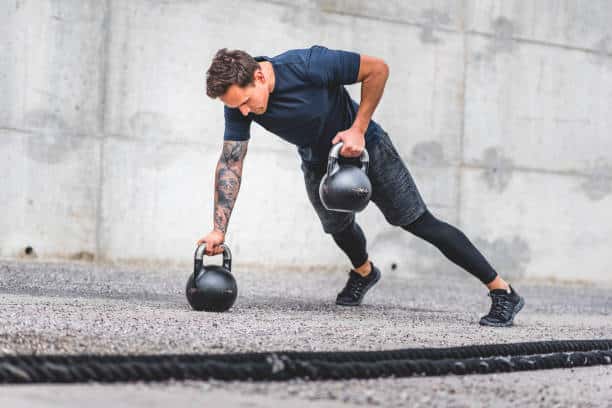
Energize Your Routine: 45 Minute Kettlebell Workout
Did you know that a 45-minute kettlebell workout can torch up to 600 calories? That’s nearly equivalent to running a 10K.
Kettlebell exercises offer a superb full-body workout that’s both quick and effective, making them ideal for busy schedules.
This routine does more than burn calories—it’s a powerhouse for building strength and boosting endurance. If you’re seeking a versatile addition to your home fitness regimen, a 45-minute kettlebell workout could be your perfect solution.
Let’s explore the benefits and discover how this workout can transform your fitness journey.
Why You Should Consider Kettlebell Workouts

If you’re looking for an efficient way to boost your fitness, a 45-minute kettlebell workout offers numerous benefits. These workouts blend strength training, functional fitness, and cardiovascular elements for a well-rounded approach. If you’re looking for an efficient way to boost your fitness, a 45-minute kettlebell workout offers numerous benefits. These workouts blend strength training, functional fitness, and cardiovascular elements for a well-rounded approach. Experts often recommend 45 minutes as an optimal workout duration to maximize calorie burn, build endurance, and enhance muscle strength without overtraining. By engaging multiple muscle groups simultaneously, kettlebell exercises help you achieve significant results in a shorter amount of time.
One major advantage is the high-calorie burn. By engaging multiple muscle groups through dynamic movements, you can burn up to 20 calories per minute. This makes kettlebell training highly effective for weight loss and improving overall fitness.
Functional fitness is another key benefit. Kettlebell exercises mimic everyday movements, enhancing your efficiency in daily tasks and various sports. This makes functional fitness a cornerstone of a 45-minute kettlebell workout.
Muscle toning is also significant. Exercises like swings and snatches target both the upper and lower body, leading to well-rounded muscle development and a balanced physique.
Don’t overlook the cardiovascular benefits. The continuous flow of kettlebell movements keeps your heart rate up, boosting cardiovascular endurance. This combination of strength and cardio makes kettlebell workouts uniquely effective.
Overall, incorporating a 45-minute kettlebell workout into your routine provides a versatile and efficient way to achieve your fitness goals, whether they involve calorie burning, functional fitness, or muscle toning.
Essential Equipment for Your Kettlebell Routine
It takes some thought and the proper equipment to begin using kettlebells. Let’s look at how to choose the best kettlebells and necessary safety gear to improve your workouts.
Choosing the Right Kettlebells
Entering the kettlebell world can be intimidating. The secret is to adhere to a trustworthy kettlebell selection guide. It is necessary to consider the material, size, and weight. Traditional or adjustable kettlebells are available. Kettlebells with adjustable handles provide excellent flexibility as your strength increases.
Starting with a weight you can manage for different exercises is advised by a good kettlebell selection guide; for beginners, this is usually between 10 and 20 pounds. You can transition to larger weights or adjustable kettlebells as you gain strength; the latter option may end up being more cost-effective over time.
Additional Gear for Safety
Exercise safety must always be prioritized. Purchasing high-quality exercise safety equipment can shield your home gym equipment and help prevent injury. Mats to cushion your training surface and gloves to increase grip and avoid blisters are crucial. This can protect your floor from damage and assist in preventing slips.
Here’s a helpful comparison to get you started with the appropriate gear:
| Equipment | Purpose | Recommended Brands |
|---|---|---|
| Adjustable Kettlebells | Flexible weight options | Bowflex, Kettle Gryp |
| Gloves | Improves grip and prevents blisters | Rogue, Harbinger |
| Mats | Prevents slips, protects floors | Gorilla Mats, BalanceFrom |
By selecting the right kettlebells and safety gear, you can make your workouts effective and safe. Happy training!
Warm-up Exercises to Prepare Your Body

It’s essential to warm up before a kettlebell workout in order to guarantee peak performance and lower your chance of damage. Your muscles and joints are better prepared for the intensity of the activity when you do efficient dynamic stretching and joint mobility drills prior to the workout.
Dynamic Stretches
Dynamic stretches are crucial for stimulating the blood vessels and muscles. These stretches are meant to mimic the movements you’ll make during your workout and involve movement.
- Leg Swings: Swing each leg back and forth to loosen up your hip flexors and hamstrings.
- Arm Circles: Rotate your arms in circular motions to activate your shoulder joints.
- Hip Circles: Rotate your hips in circular movements to improve mobility and increase flexibility.
- Torso Twists: Twist from side to side to engage your core and warm up your spine.
Joint Mobility Drills
To improve joint mobility and prime your body for the demands of kettlebell movements, include joint mobility drills in your warm-up regimen. The goal of these exercises is to increase your joints’ flexibility and range of motion.
- Ankle Circles: Rotate your ankles in both clockwise and counterclockwise directions to improve flexibility.
- Wrist Flexion and Extension: Flex and extend your wrists to prepare them for gripping the kettlebell.
- Shoulder Mobility Drills: Perform shoulder dislocates with a resistance band to increase shoulder joint mobility.
- Neck Rotations: Gently rotate your neck from side to side to relieve tension and improve flexibility.
You can improve joint mobility and greatly reduce the risk of injury by including dynamic stretching and joint mobility routines in your warm-up before a workout. By doing these exercises, you can make sure your body is ready for the upcoming kettlebell session and train safely and efficiently.
45 Minute Kettlebell Workout Breakdown

Dive into this thorough 45-minute kettlebell training plan designed to enhance your fitness results. The workout mixes flexibility, endurance, and strength. Every exercise is designed to fit into a high-intensity circuit, which guarantees effective calorie burning and muscular toning.
The three parts of the plan are the warm-up, the primary workout, and the cool-down. This method guarantees that your body is suitably rested and ready for action.
- Warm-Up (5 minutes): Focus on dynamic stretches and joint mobility drills to prepare your muscles.
- Main Workout (35 minutes):
- Goblet Squat: 3 sets of 12 reps.
- Kettlebell Swing: 4 sets of 15 reps.
- Single-Arm Press: 3 sets of 10 reps on each side.
- Renegade Row: 3 sets of 8 reps on each side.
- Russian Twists: 3 sets of 20 reps.
- Cool-Down (5 minutes):
Incorporate static stretches and controlled breathing exercises.
Incorporate the following exercise sequence to keep your muscles engaged and your heart rate elevated. Here’s how the main workout segment is structured:
| Exercise | Sets | Reps | Rest |
|---|---|---|---|
| Goblet Squat | 3 | 12 | 45 seconds |
| Kettlebell Swing | 4 | 15 | 30 seconds |
| Single-Arm Press | 3 | Ten each side | 60 seconds |
| Renegade Row | 3 | Eight each side | 45 seconds |
| Russian Twists | 3 | 20 | 30 seconds |
Recall that you can modify this intense circuit according to your degree of fitness. Always pay attention to your physical needs. Including this kettlebell training plan in your routine can help you achieve your fitness objectives.
Cool-down and Stretching Post Workout
It’s important to schedule time for a proper cool-down following a vigorous kettlebell practice. This facilitates relaxation, lessens discomfort in the muscles, and aids in post-workout recovery. Static stretches and deliberate breathing exercises are both important components of a complete cool-down that speed up the healing process.
Static Stretches
A comprehensive static stretching program greatly facilitates recovery from a workout. For around thirty seconds, you should hold each stretch to let your muscles progressively lengthen and relax. Concentrate on your main muscular groups, such as your calves, shoulders, hamstrings, and quads. Stiffness can be avoided, and tightness can be relieved with deep static stretches.
- Hamstring Stretch: Sit on the ground with one leg extended and the other bent, reaching towards your toes.
- Quadriceps Stretch: Stand on one leg and pull the opposite foot towards your glutes, keeping your knees close together.
- Calf Stretch: Push against a wall with one leg back, keeping the heel on the ground.
- Shoulder Stretch: Bring one arm across your body and hold it with the opposite arm for an effective stretch.
Breathing Exercises
Adding deliberate breathing exercises to your cool-down routine improves mental clarity and relaxation. These exercises are basic yet powerful tools to aid in post-workout recovery. Breathe deeply and diaphragmatically, using your mouth to exhale and your nose to inhale.
| Exercise | Description |
|---|---|
| Box Breathing | Inhale for 4 seconds, hold, exhale, and hold again for 4 seconds. Repeat. |
| Diaphragmatic Breathing | Lie on your back with your knees bent. Place one hand on your chest and the other on your abdomen. Breathe deeply, ensuring your abdomen rises more than your chest. |
Spending a few minutes on these regulated breathing exercises and static stretching regimens will help you recuperate from your workout more fully. This guarantees that you’ll feel rejuvenated and relaxed for your upcoming session.
Tips for Maximizing Your Kettlebell Workout

Effective kettlebell training can truly elevate your fitness routine. To achieve the best results, focus on a few key strategies:
1. Maintain Consistency: Make kettlebell exercises a regular part of your week. Sticking to a consistent schedule helps you build momentum and see steady progress.
2. Implement Progressive Overload: Gradually increase the weight or intensity of your exercises. This approach challenges your muscles and helps prevent plateaus. Start with lighter kettlebells and progressively work your way up, allowing your body to adapt and strengthen over time.
3. Integrate a Well-Rounded Fitness Program: Combine your kettlebell routine with other forms of exercise, such as cardio, flexibility training, and yoga. This comprehensive approach not only enhances overall fitness but also keeps your workouts varied and engaging.
By following these tips, you’ll maximize the benefits of kettlebell training and keep your fitness journey both effective and exciting.
FAQ for a 45-minute Kettlebell Workout
What are the benefits of kettlebell exercises?
Exercises using kettlebells have many advantages, including enhanced cardiovascular health, strength, and endurance. They’re excellent for full-body exercises because they effectively burn calories and tone muscles. Kettlebell exercises are also quite easy to add to a home training program, which makes them ideal for people with hectic schedules.
Why should I consider adding kettlebell workouts to my fitness regimen?
Because they improve calorie burn, foster full-body muscle toning, and offer functional fitness advantages, kettlebell workouts are a great complement to any training regimen. These exercises are a great addition to any comprehensive fitness routine because they are effective, improve cardiovascular health, and aid in weight loss.
How do I choose the right kettlebells for my exercises?
Think about your training objectives, current strength level, and personal preferences while choosing kettlebells. Beginners should begin with lower weights and work their way up to a greater level as they get more comfortable. For further adaptability, you can select adjustable kettlebells instead of standard ones. Make sure the materials are sturdy and the grip is comfortable.
What additional gear do I need for kettlebell workouts?
In addition to kettlebells, safety equipment is essential for preventing injuries. This includes mats to protect your floor and prevent slides, as well as exercise gloves for improved grip. Putting on appropriate footwear and clothing for exercise can also improve performance and safety.
What warm-up exercises should I do before a kettlebell workout?
Joint mobility exercises and dynamic stretches are essential for getting your body ready for a kettlebell session. These workouts lower the chance of injury, enhance flexibility, and promote blood flow. Leg swings, arm circles, and hip rotations are a few examples.
Can you describe a 45-minute kettlebell workout?
Typically, a 45-minute kettlebell workout consists of a high-intensity circuit that works for various muscle groups. Exercises like Turkish get-ups, goblet squats, and kettlebell swings are included in it. Each exercise in the workout has a predetermined number of sets and repetitions to ensure a thorough full-body challenge.
What cool-down exercises should I do after a kettlebell session?
It’s important to cool down with static stretches and breathing techniques after a kettlebell session. These exercises facilitate relaxation, lessen muscle discomfort, and speed up healing. To reduce your heart rate, concentrate on stretches that target your primary muscle groups and use regulated breathing techniques.
How can I maximize the effectiveness of my kettlebell workouts?
Be consistent and adhere to a set strategy if you want your kettlebell workouts to be as beneficial as possible. To prevent plateaus, use progressive overload, which involves progressively increasing weight or intensity. Incorporate kettlebell exercises into a comprehensive fitness regimen that also incorporates flexibility and cardiovascular conditioning.



